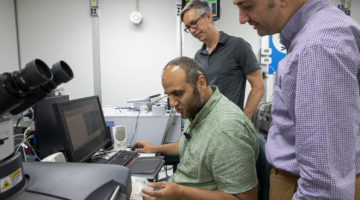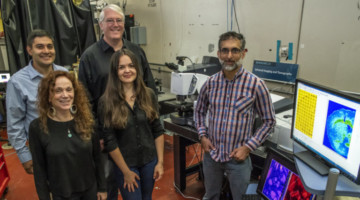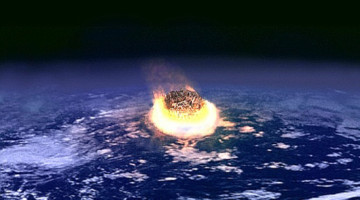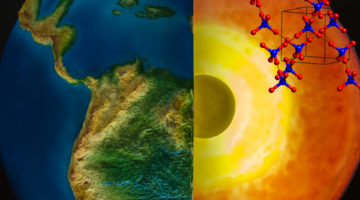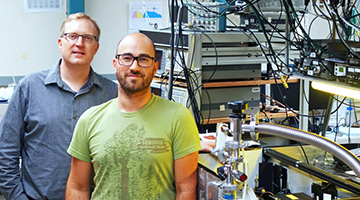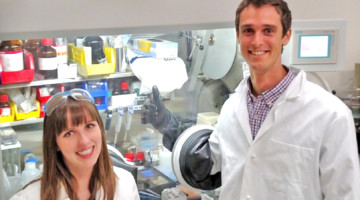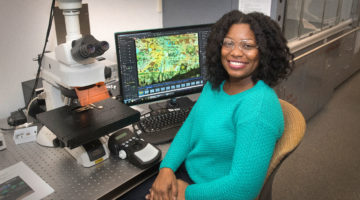Researchers from Cairo University worked with teams at the ALS to study soil and bone samples dating back 4,000 years. The experiments are casting a new light on Egyptian soil and ancient mummified bone samples that could provide a richer understanding of daily life and environmental conditions thousands of years ago. Read more »
Clues to the Solar System’s Original “Bricks and Mortar”
In comet dust, researchers discovered composite organic-inorganic mineral grains that are likely to be the original “bricks and mortar” of the solar system. “Forensic” samples preserved from the birth of the solar system allow investigations into the nature of the atomic and molecular ancestry of the terrestrial planets and life on Earth. Read more »![]()
![]()
Infrared Beams Show Cell Types in a Different Light
By shining highly focused infrared light on living cells, scientists hope to unmask individual cell identities and to diagnose whether the cells are diseased or healthy. Their focus is on developing a rapid, noninvasive way to easily identify cell types and features within living cells, to aid in biological and medical research. Read more »
From Moon Rocks to Space Dust: Berkeley Lab’s Extraterrestrial Research
Berkeley Lab has a well-storied expertise in exploring samples of extraterrestrial origin. This research—which has helped us to understand the makeup and origins of objects within and beyond our solar system—stems from long-standing core capabilities in structural and chemical analyses and measurement at the microscale and nanoscale. Read more »
Experiments at Berkeley Lab Help Trace Interstellar Dust Back to Solar System’s Formation
Experiments conducted at the Department of Energy’s Lawrence Berkeley National Laboratory (Berkeley Lab) helped to confirm that samples of interplanetary particles—collected from Earth’s upper atmosphere and believed to originate from comets—contain dust left over from the initial formation of the solar system. Read more »
Phase Diagram Leads the Way to Tailored Metamaterial Responses
Researchers discovered an innovative way to independently control two optical responses in a single-material system by utilizing the material’s phase diagram. This unique combination of material, methods, and results could lead to a paradigm shift in the design of metamaterial devices that manipulate light. Read more »![]()
![]()
Diamonds From the Deep: Study Suggests Water May Exist in Earth’s Lower Mantle
A new study suggests that water may be more common than expected at extreme depths approaching 400 miles and possibly beyond—within Earth’s lower mantle. The study explored microscopic pockets of a trapped form of crystallized water molecules in a sampling of diamonds from around the world. Read more »
Watching a Quantum Material Lose Its Stripes
In the world of microscopic physics, periodic stripe patterns can be formed by electrons within so-called quantum materials. Scientists have now disentangled the intriguing dynamics of how such atomic-scale stripes melt and form, providing fundamental insights that could be useful in the development of novel energy materials. Read more »
Modulating Infrared Light with 2D Black Phosphorus
Two-dimensional materials represent a promising new frontier in the field of optoelectronics. Most progress so far, however, has been in the visible-light range. Now, at the ALS, researchers have measured the infrared transmission spectra of ultrathin samples of black phosphorus under an applied electric field. Read more »![]()
![]()
Grad Student Benefits from ALS, Brookhaven Collaboration
Stony Brook grad student Tiffany Victor flies to California several times a year to use infrared beams at the Advanced Light Source. Unlike the infrared microscope at Brookhaven National Laboratory, the extremely bright infrared light from the ALS’s synchrotron beamlines improves the image quality and resolution in order to study the interface between the plant and fungus. Read more »
